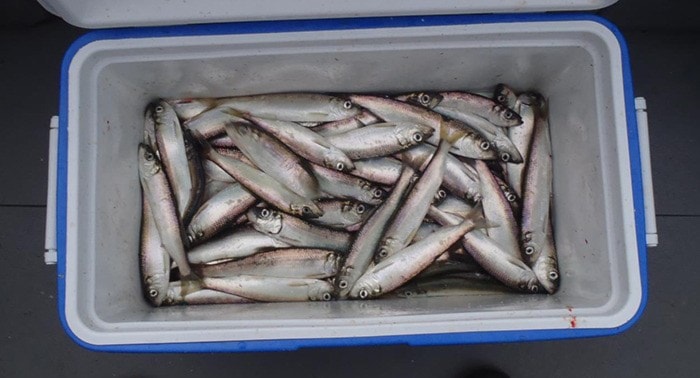I am fascinated by huge migrations fish and other creatures. In this case it is the annual migration of Pacific herring into the Straits of Georgia and other coastal waters. By sheer numbers of individuals and great schools of fish it is huge.
The greatest concentration of fish occurs in local waters including Pacific Fisheries Management Areas (PFMA) 14 to 18 in the Strait of Georgia. There are five major management areas on our coast plus two small areas with minor stocks.
The Strait of Georgia population is by far the most abundant of the five, and economically important to the people of British Columbia for over a century and to the aboriginal people they have been an important food source for thousands of years. The aboriginal method of harvesting roe on kelp is the most conservation-oriented method because the fish live to spawn again.
The adult fish migrate into the Strait of Georgia in the late fall from the open ocean and remain until they spawn in the spring. On average they live seven or eight years and will go through several spawning runs after reaching maturity at age three years. There are a few small resident populations in the Strait, but the most abundant are the migratory stocks.
The 2015 roe herring is from Feb. 10 to April 30; target catches are about 15,500 short tons for seines and about 14,000 tons for the gill net fishery and is based on a 20 per cent harvest of the projected biomass. There was an earlier food and bait fishery that harvested 585 tons.
The target fishery is based on an estimated abundance of spawning biomass about 175,000 metric tonnes. At about three fish to the pound this gives an approximate number of 500 million individual adults. As of this writing I would estimate most of them are crowded into the waters between Cape Lazo and Campbell River. Depending on the fickle decisions of the fish, that guess can change locations very quickly. There are concentrations of herring throughout Area 14 waters from Parksville to Courtenay.
Pacific herring are a foundation species in that so many species of fish, animals, birds and even human beings depend on their abundance to have a healthy ecosystem that supports many forms of life.
The roe is spawned on sea weeds, rocks and anything that they can deposit the sticky masses. They hatch in about two to three weeks. If you don't think it is sticky try cleaning up after catching some herring and having the spawn on your clothes, nets, etc.
While the herring are intent on spawning and getting back out into the open ocean they are targeted at every level of the spawning run. For the next few weeks local waters will teem with large concentrations of gulls, seals and sea lions that are visible on the surface. Below the surface there will be millions of fish and other predator species joining in the feast.
For residents new to the Valley I recommend you take a few walks along the beaches from Parksville to Miracle Beach Park to see first-hand this incredible display of nature. Prime times will be from now until the end of April. The weather is forecast to be sunny and warm much of the time, unlike our east coast. One easy way to spot an active spawn in process is to observe large concentrations of gulls and eagles actively feeding in shallow waters close to shore.
It is difficult to over estimate the importance of the annual run of Pacific herring to the people living along the shores of the Straits of Georgia. This past season for recreational anglers fishing chinook salmon has been one of the best in recent memory. Most regular season anglers have had to be selective, or they would soon run out of spaces for their season limit of 15.
This unexpected abundance has to be connected to reliable food sources for the salmon in the form of abundant herring stocks. Herring are an important human food source in their own right.
This past season a small number of seine boats were actively involved in the harvest of 585 tons of bait and food herring. The daily limit for recreational anglers is 20kg with two day possession limit. That will make considerable roll-ups and smoked herring.
Information sources: The Sea Among Us by Richard Beamish and Gordon McFarlane (2014); 2014/2015 Commercial Plan for Roe Herring.
Ralph Shaw is a master fly fisherman who was awarded the Order of Canada in 1984 for his conservation efforts. In 20 years of writing a column in the Comox Valley Record it has won several awards.
